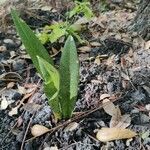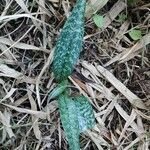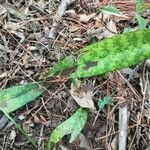Plants terrestrial; pseudobulbs conical, 20-30 x 10-15 mm; roots simple, 5 mm thick, surface roughly verrucose; leaves single per pseudobulb, sessile or with a petiole to 20 mm long, blades lorate-elliptic, acute, erect, green speckled with darker spots, 110-180 x 25-45 mm. Inflorescences racemose, rarely paniculate, 200-300 mm tall; sheaths lax, 3-4, acuminate, papery, 25-40 mm long; bracts papery, narrowly lanceolate, half as long as the 10 mm long pedicels. Flowers greenªish yellow with a bright yellow, red-streaked lip, 15-20 mm in diameter. Sepals subequal, spreadªing, lorate to oblanceolate, obtuse-apiculate, conªcave, 8-11 x 3.5-4 mm; laterals slightly oblique. Petals erect, elliptic, obtuse-apiculate, 8-10 x 4-5 mm. Lip 8-9 mm long and 11 mm wide, crest of transverse ridges at entrance to spur; midlobe shallowly lobulate, lobes rounded; side lobes porªrect, rounded, 3-4 mm tall; spur clavate, rounded or emarginate, 4-6 x 2 mm. Gynostemium 2 mm tall.
Plants 20–43 cm. Roots fibrous, white, stout. Pseudobulbs dark green, ovoid to orbicular, 2–5 × 1–3 cm, often concealed by imbricate fibrous sheaths or 1 closely appressed sheath, 1-leaved at apex. Leaves: blade nearly erect, olive green with dark green mottling, oblong-elliptic, abaxially keeled, 12–32 × 3.5–5.5 cm, succulent leathery, apex acute. Inflorescences lax, 10–42 cm; peduncles erect, slender, with few remote sheaths. Flowers 5–15, 9–15 mm wide; sepals and petals light brown to pinkish green; sepals 8–12 × 2–3 mm; dorsal sepal linear-oblong, apex acute; lateral sepals slightly falcate; petals oblong-elliptic, 12 × 4 mm, apex acute; lip white with 2 parallel pink blotches, 9–14 × 8–12 mm, lateral lobes erect, white with thin, radiating purple lines, orbiculate, spur curved, 5 × 2 mm; column curved, white, 5–7 mm. Capsules pendent, elliptic-oblong, to 3.5 cm.
Lip 7–9 mm long, 3-lobed; side lobes erect; mid-lobe 3.5–4.2 mm long, 6–10 mm wide, broadly obovate or reniform, emarginate; disk with 2 approximate, divergent, glabrous basal keels; spur 4–5 mm long, stout, straight, bulbous at tip.
Leaf with a petiole 1–2 cm long, articulated ± at the base; lamina 10–30 × 2.5–5 cm, oblong-oblanceolate or oblong-elliptic, conduplicate towards the base, coriaceous, grey-green mottled with dark green.
Sepals and petals greenish-white, greenish-pink or straw-coloured; lip white with 2 purple-red blotches at the base of the mid-lobe; side lobes purple-veined.
Sepals 7–13 × 2–3.2 mm, linear-ligulate or narrowly oblanceolate, obtuse to acute, the dorsal sepal erect, the lateral sepals deflexed.
Pseudobulbs 2–4 × 1.5–2 cm, ovoid, oblong or cylindrical, covered when young with pale brown imbricate cataphylls, 1-leafed.
Inflorescence erect, simple or with 1–2 short branches, fairly laxly 10–20-flowered.
Bracts lanceolate, acuminate, up to 20 mm long at base of the inflorescence.
Glabrous, terrestrial herb 20–40 cm high; roots stout, c. 4 mm in diameter.
Column 4–5 mm long, 2 mm wide, oblique at base or with a short foot.
Petals 8.5–11 × 2–4.5 mm, oblong-elliptic, oblique, obtuse.
Pedicel and ovary 10–12 mm long.




